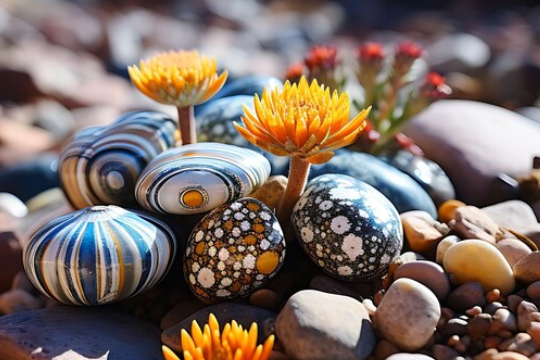Unusual things in nature refer to the enormous and intricate network of natural occurrences, habitats, and living organisms that comprise Earth. It includes everything from the tiniest microbes to the largest mountain ranges, from the ocean’s depths to the sky’s expanse. Earth, nature is a dynamic and intricate system that offers countless chances for inquiry, learning, and awe. It serves as a reminder of how intertwined we are with nature and how crucial it is to protect it.

Some significant features of unusual things:
- Sailing Stones
- Lithops
- Cave of the Crystals
- Bloodwood Trees
- Underwater Crop Circles
- Catatumbo Lightning
1. Sailing Stones is the unusual things

The geological phenomenon known as sailing stones, or sliding rocks, is most famously observed in Death Valley. These stones, which range in size from boulders to pebbles, appear to be moving across the parched lake bed and leaving extensive trails in their wake. The movement of these stones baffled scientists and tourists for decades because there were no overt indications of animal. Strong winds, ice, and magnetic fields are just a few of the many theories that have been put forth to explain the phenomenon.
They found that on chilly winter nights, thin sheets of ice can form on the playa’s surface under certain circumstances. A slick surface results from the ice melting in response to the sun’s heat. If the wind is strong enough and the ice is thin enough, the stones will push their way along the slick surface, leaving behind their characteristic trails. Even though the precise circumstances needed for sailing stones to move are not very common they are beyond explanation. These wandering rocks have drawn both tourists and scientists to the Racetrack Playa, making it a popular destination.
2. Lithops is the unusual things

Known by most as “living stones,” lithops are a kind of succulent plant that are indigenous to southern Africa. This is an interesting group of plants that have evolved to resemble tiny stones or pebbles in order to help them blend in with their arid environment and evade herbivores. Typically, a lithop consists of two thick, meaty leaves joined together. There is often a translucent window-like area at the top of the leaves that lets sunlight in and enables photosynthesis to take place inside the plant. Lithops rely on their water-storing tissues to survive during dry spells, using the reserves kept in their leaves. The cleft between lithops produces tiny, daisy-like flowers when the conditions get better.
3. Cave of the Crystals

The magnificent Cave of the Crystals, also known as Cueva de los Cristales, is located in Naica, Mexico. This well-known cave contains some of the largest natural crystals ever discovered on Earth, with lengths of up to 11 meters (36 feet) and weights of several tons. While excavating a tunnel for the Naica Mine in 2000, miners discovered the vast network of interconnected caves known as the Cave of the Crystals. The cave is located approximately 300 meters (980 feet) below the surface. The main mineral present in the crystals of the cave is gypsum, which is the result of groundwater rich in minerals evaporating over millions of years.
4. Bloodwood Trees

Tropical regions worldwide, such as Africa, Australia, and South America, are home to a diverse range of trees classified as bloodwood trees, encompassing multiple genera and species. The name “common eel” comes from the characteristic red sap that these trees release when they are broken or chopped. Because of their characteristic red sap, bloodwood trees are known for their exquisite appearance and unique characteristics. The vivid color of the sap is a result of the presence of several substances, such as pigments and tannins. Native Americans have long used the sap of bloodwood trees for a range of uses, including traditional medicine and textile dye.
5. Underwater Crop Circles

A remarkable natural occurrence found in the waters off the coast of Japan is underwater crop circles. Male pufferfish use their fins to sculpt the sand-covered ocean floor into intricate circular patterns that resemble terrestrial crop circles. During the mating season, male pufferfish create these underwater masterpieces with the intention of attracting females for mating. These intricate, sometimes several feet in diameter, circles they carve out of the sand with their delicate fins.
The purpose of these underwater crop circles is to serve as nests for the pufferfish’s eggs. When the nest is finished, females examine the elaborate patterns and select a mate based on how well-made he is. The male tends to the female’s eggs until they hatch, which she lays in the middle of the nest. These underwater crop circles serve as a remarkable example which animals will go to ensure the survival of their offspring.
6. Catatumbo Lightning

Venezuela’s Catatumbo River mouth is home to the captivating natural phenomenon known as Catatumbo Lightning. The almost constant lightning strikes that light up the night sky with brilliant bursts of light are what distinguish this exceptional atmospheric show unusual things. With lightning strikes occurring up to 260 nights a year, lasting for hours at a time. The Catatumbo Lightning phenomenon is one of the most frequent lightning displays on Earth. When cool air from the Andes Mountains collides with warm Caribbean winds to create the perfect storm conditions for electrical storms, lightning is most active during the rainy season, which is normally from April to November.
In the Catatumbo region, lightning strikes occur frequently and with remarkable intensity. Thunderstorms: An hour can record up to 280 lightning strikes. The lightning strikes, which are visible for miles, cover the surrounding area in an eerie glow. They can reach heights of up to 5 kilometers (3.1 miles). For an extended period, Venezuelans have regarded the Catatumbo lightning phenomenon as a marvel of nature and a cause for national pride. Upon completion of the nest, females scrutinize the intricate designs and choose a partner based on his craftsmanship. Scientists and researchers who are interested in learning more about the atmospheric conditions that lead to such intense.
Read Also: The top 5 strange places in the world






